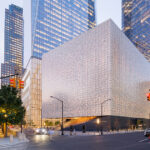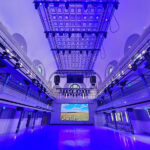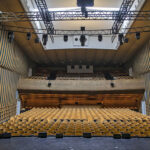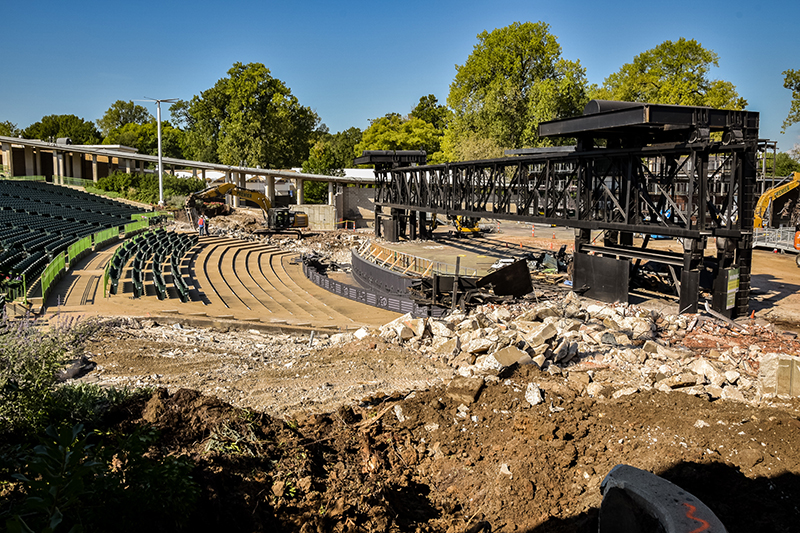
The “Muny” in St. Louis Revamps for Another Century of Summer Performances
In May of 2018, The St. Louis Municipal Opera Theatre, a.k.a. The Muny, announced its Second Century Capital Campaign, a $100 million fundraising effort that would fund major capital improvements, including a complete rebuild of its stage. At the time, Muny president and CEO Denny Reagan commented, “As we look toward our second century, the capital improvements to the facility and endowment support that will result from this campaign are vital to the future of The Muny.”
After several years of planning, the staff of The Muny were ready to pull the trigger on the project at the conclusion of the 2018 summer season. The century-old stage was torn down and construction began; all with the goal of having it rebuilt and ready to go for the 2019 season in the spring.
The rebuild addressed critical structural needs and allows The Muny to utilize stage technology that has become standard across the industry — an all LED lighting system, state-of-the-art controls, versatile automated stage decking, stage lifts and new scenic LED screens. The results of the first phase of construction were completed on schedule and Guys and Dolls hit the “new” boards on June 10, 2019 — five days after power and data were supplied to the theater. Production manager Tracy Utzmyers and lighting designer Rob Denton, who have both been very involved in this massive renovation, spoke shortly after the re-opening about the process, the challenges and the stunning results.
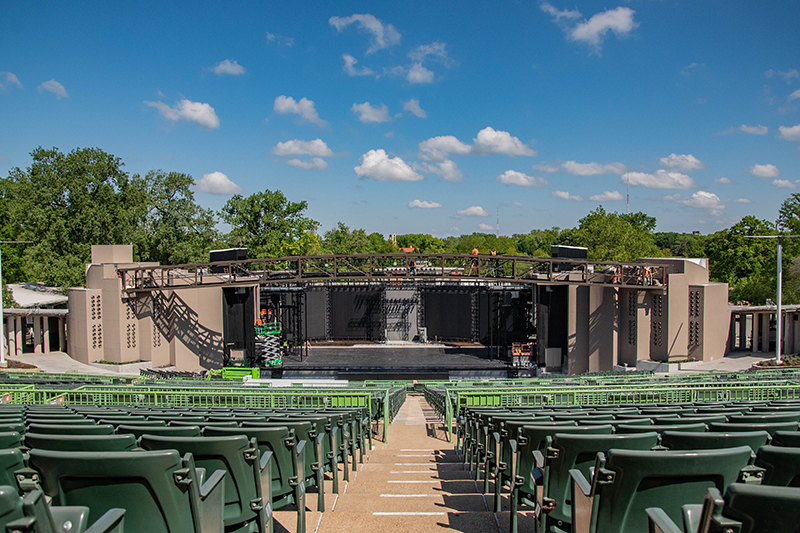
Tear It Down; Build It Up
Utzmyers, who has been at The Muny for 14 seasons (11 of them as the production manager), helped oversee the renovation. “I’ve got to say I’m really proud of this renovation. It’s a really scary thing to tear down your theater,” she comments. “I am so pleased with what we’ve come up with. It’s working really great, and I think it’s beautiful. I hope people love it; I hope a lot of people come to see it.
“I think overall we’re very happy,” Utzmyers continues. “There are small tweaks, of course, that still need to get worked out, and we’re learning about it all still; how to make sure that it’s consistent. But we totally expected that, and overall, it’s been really successful. The LED screens look better than I thought they would. The lighting is gorgeous; I mean it’s just incredible. I thought the hurdle between changing from traditional incandescent fixtures to LED fixtures was going to be tough; that it was going to take us all season to figure it out. We brought all the designers in, and it took a night for them to be like, ‘Oh, I see. I can do this, this, this and this.’ And it’s beautiful.
“The new followspots have been very smooth, because the spots are remotely controlled now,” Utzmyers adds. “The automation is a big addition; certainly, something that we’re not used to, but it’s working really well, and we’re learning about it. It’s about getting a dialogue of how to make it work in our short tech period. So, just figuring out what needs to happen prior to getting to tech; that stuff we’re still tweaking, but I’m really pleased with how it’s coming along, honestly. I’m kind of blown away at how well everything’s working out. Knock on wood!”
In a New Light
In the past, The Muny used incandescent PAR cans and ellipsoidals along with 4,000W discharge lamped followspots. The entire lighting system has now been renovated, changing out all the stage lighting from incandescent to LED.
“We decided if we were going to do it, let’s do it,” says Utzmyers. “I’ve got to tell you, it was a little scary, but I’m incredibly pleased with the outcome; it’s really beautiful. I was at a focus call the other day, and the lighting designer, John Lasiter — who during planning, was not completely convinced that the LEDs were the right choice — said to me, ‘look at that light. I’m hard pressed to tell that’s not an incandescent fixture.’ I don’t know that there’s better praise.”
Denton, who was heavily involved in the planning for the renovation and has been lighting productions at The Muny for the past eight years, worked closely with Chris Barbee of Bandit Lites, and the Bandit Lites systems integration team on what they were looking for in terms of lighting for the new space. The planning started about three years earlier and while they knew that they wanted to go all LED, there were no exterior-rated LED ellipsoidals available at the time. The Muny team spoke directly to Chauvet and product manager Ben Dickmann about their lighting needs.
Chauvet’s Dickmann explains this inspiration to create exterior-rated LED luminaires. “I was up visiting The Muny on a goodwill trip and I was looking at their rig and all these PAR cans and ellipsoidals. I thought that there’s got to be a better way because they were replacing lamps constantly and having to constantly maintain those fixtures that obviously weren’t designed to be hanging out in the rain for four months out of the year. That got me thinking why can’t we do this a better way? At the time, outdoor-rated ellipsoidals were all guts of fixtures encased in shrouds, with no easy way of being able to focus or do shutter cuts. We at Chauvet had been getting into IP wash fixtures at that time and the inspiration of The Muny is what really led to the development of our first IP ellipsoidal, the E-260WW IP.”

The prototype of the new IP ellipsoidal was presented to Denton and The Muny team. “Chauvet had just come out with their IP version of the warm white light ellipsoidal. They built it based on inspiration from us, so we looked forward to trying it,” says Denton. “We tested this outdoor version of ellipsoidal and it was amazing.” After working with the warm white version of the exterior-rated ellipsoidal, Denton asked if Chauvet would produce an IP version of their full color LED ellipsoidal.
Dickmann recalls, “In the design process, Rob came to me and said, ‘We love the warm whites, but we really love your E-910 color fixture. Could you do that in an IP version as well?’ The E-910FC IP really came about because of them.” Chauvet agreed to produce the E-190FC IP and delivered them with two months to spare before the 2019 season got underway. “They found a way to do it and they got them to us,” adds Denton. “They had an eight-month time period and got them to us; we really appreciated their efforts.”
“I’ve been extremely fortunate to work with these LED lights,” says Denton. “There’s a subtle quality to the light; the color’s very subtle, but also very vibrant. It doesn’t feel flat on the skin. It was just great on a tech night to see them in action.” Denton is using the COLORado Solo Batten for his cyc lighting needs. “Each one is a meter long and incredibly bright,” says the LD. “I also have a system of PARs with the Solo 3 in RGBW.” In the inventory, they have some of the new IP65 rated gobo rotators from Chauvet. “We are using the gobo rotators in Guys and Dolls and Kinky Boots. Every one of the IP ellipsoidals has the connections for power and data, they just patch them in and it’s ready to go.”
The stage lighting rig for the 2019 rep plot included 117 E-260WW IP and 248 E-910FC IP ellipsoidals, which are “my workhorses in the rig,” comments Denton; 164 Chauvet COLORado 3 Solo and 16 COLORdash PAR H12IP wash lights; and 26 Chauvet COLORado Solo Batten for his cyc lighting; the footlights consist of 42 Philips Color Kinetics’ ColorGraze MX4 RGBA. For followspots The Muny used a six station Follow-Me remote followspot control rig paired with seven locally rented Elation Proteus Maximus luminaires.
They were going to hold off on choosing new followspots in this phase of the renovations, but Barbee recommended they get a demonstration of the Follow-Me remote followspot control system. Utzmyers and LD Denton were sold, and they chose seven Elation Proteus Maximus IP65-rated automated lights paired with the Follow-Me system for the theater’s followspots. “We’re pretty excited to have the Elation units and the Follow-Me system,” says Utzmyers. “We thought it would take the crews a lot of time to get up to speed with the targeting system of Follow-Me, but they had it down in about an hour.”
Denton is also a fan of the Follow-Me system. “I love it. I mean there was a little bit of a learning curve for the crew working with it for the first time, but they had it down quickly; at the first tech night, when they were going full at it, they were extremely smooth. They were very pleased with it. The joystick and targeting system are so user-friendly. The Proteus Maximus units are extremely bright. They have an even field of light and produce good quality cover. We are really, really pleased. For once, we have a beautiful angle for the followspots. We have four FOH spots from the bridge and two side spots. Then I have one back spot as well which ties to my front spots; the same operator controls the back and the front spots.”
In Control
Lighting control at The Muny was previously an ETC Ion console, which has been seriously upgraded with the now much larger ETC control system post renovation. “I think the biggest thing that I like with the new control system, is the ability to now map out the entire space with the magic sheets in the ETC consoles,” comments Denton. “We went from a rig of maybe 450 channels to over 1,300 channels because of all the footlight and the cyc light parameters. It really helps to be able to visually see what is happening on stage and find the light quickly. We now have an ETC TI console and an ETC Gio console on the third floor where the lighting is controlled. On the first floor tech level we have an ETC @5, so we’re running three consoles all the time. The main setup is really, the TI and Gio for programming and then to run the show. The house lighting is all controlled via an ETC Paradigm system.”
The new ETC control system consists of: RPU 24K; TI 24K; Gio 24K; @5 24K; and two ETC RVIs. Networking includes 36 Pathway Connectivity 4-Port DMX Nodes and two ETC Show Control Gateways that link to the Sound department and to the Video department’s disguise media servers.

Wireless Control
As a part of the renovation, the lighting team was looking for a wireless DMX and dimming system that was IP65-rated, versatile, and reliable enough to work for productions that change weekly and run outdoors during the summer months in St. Louis, MI. The lighting team mounted City Theatrical, Inc. (CTI) SHoW DMX Vero transceivers to the lighting bridge over the stage. These wireless DMX transceivers are IP65-rated and able to withstand outdoor elements while providing DMX data to LED lighting fixtures, including those installed on a turntable, across this vast, steel-clad stage.
“We needed a reliable and powerful wireless DMX system that could hit the whole stage from a new light bridge without interfering with other wireless feeds,” LD Denton commented. “I had used City Theatrical’s wireless DMX for years on Broadway and tours, and knew it was reliable. That’s why we now use it to control stage lighting at The Muny.”
The lighting design team selected and installed 10 QolorFLEX SHoW DMX Neo 4×2.5A Dimmers for their precise dimming curve and seamless connection with SHoW DMX Vero and Neo wireless DMX products. These dimmers are now used in shows for wireless practicals in scenic lighting.
Guys and Dolls opened five days after power and data were supplied to the theatre and in those five days, the lighting team was able to check and tune color palettes for the 700 LED lighting fixtures from Chauvet, as well as the Chauvet F4IP video panels. The lighting team used CTIs DMXcat Multi-Function Test Tool for troubleshooting. “When we took on this project, we knew we were trying to push the world of outdoor theatre forward,” says Denton. “There’s no room for error — we rely on everything to be in working order, and easy to troubleshoot and fix. DMXcat has made this easy.”
The systems integration was provided by Bandit Lites. “Bandit has been an excellent partner for several years,” says Utzmyers. “They’ve been great to work with as always. We’ve been really happy to have them as well as all the vendors on board.”
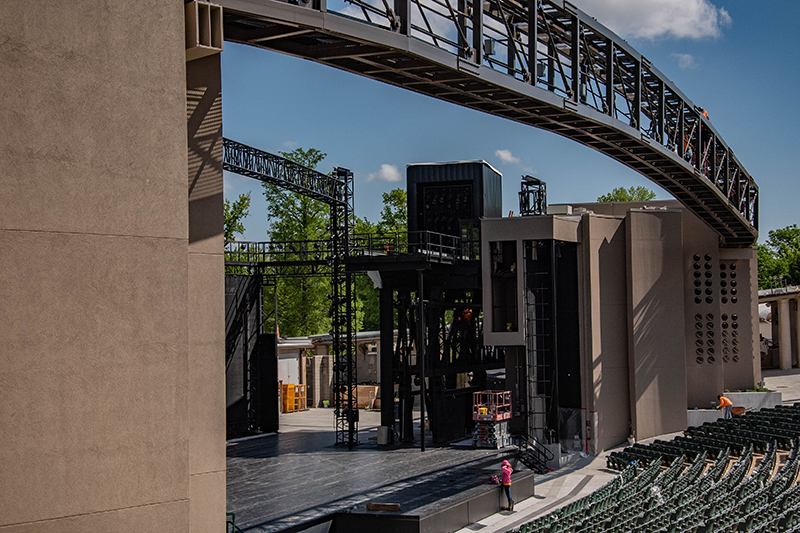
A Better Place to Hang a Light
Because The Muny doesn’t have a roof, the old lighting positions were challenging, to say the least. “We still stay true to keeping this space open to the sky and the stars,” explains Denton. “One of the main challenges was where the lighting positions were located. They were hard to shoot past the torm legs and get full coverage of the stage. We didn’t really have the ability to focus light in to just center stage. I only had ability to do center stage across the whole 60- or 80-feet. It was all based on either two-color or three-color wash systems. We’ve never had any over stage positions; there’s never down light here at The Muny. The old front of house position was a cable suspension bridge. When you went to focus, the crew had to balance their weight, so they didn’t tip up or down as they were focusing. It wasn’t rigid.”
One of the biggest improvements in terms of the lighting positions was the new FOH lighting bridge that replaces the old suspension cable version. Denton and the lighting crew are more than happy to see the old swinging bridge replaced. “It is now a 183-foot span of structural steel bridge that’s lighter-looking and airier, yet much more stable,” explains Denton. “It’s now supporting more lighting equipment; we have 160 lights hung up there. Four of those lights being the Proteus Maximus automated lights from Elation, that we pair with the Follow-Me system for our followspots; those hang underneath the bridge.”
They also wanted to improve the side lighting positions and addressed those as well in the renovation. “We designed two tracking towers that Tait also built,” says Denton. “These two positions, which are mid-stage just upstage of the scenic booms, can be tracked off stage back into garages after the strike and the equipment is protected in the off-season. Those two positions are huge for us.”
As a part of the scenic and staging upgrades, Tomcat was brought in by Tait and was tasked to provide two truss systems, which included a downstage clear span truss structure and an upstage ground supported structure. The downstage system spans the entire cross stage length at an approximate distance of 112 feet. Supporting the spans are Tomcat custom steel end support towers. The upstage system is comprised of two 42-foot towers, constructed from Tomcat custom-designed 30-inch-by-28-inch spigoted truss, which support an approximate cross-stage system span of 82-feet. Both downstage and upstage spans utilize Tomcat’s custom 40-inch-by-30-inch extra heavy duty spigoted truss profile with diagonals on all faces, which offer The Muny a flexible system that can be outfitted for specialized lighting, sound and performer flying needs.
Denton and the lighting team are pleased with the renovations, as he notes, “The renovation is fantastic. We spent years really working all of this out. We’ve gone from what was 20-year old technology, to a complete modernization of everything. Everybody’s having to relearn things or pick up new skills fast to accommodate all of this new equipment.”
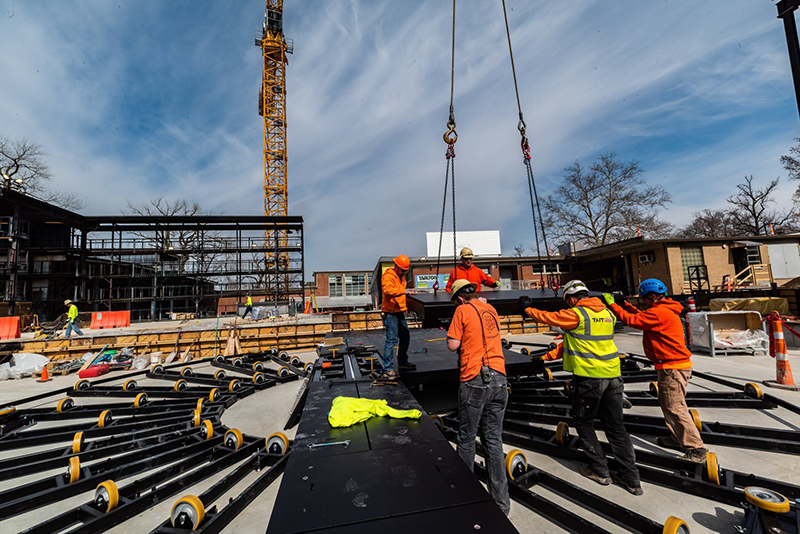
Going Round and Round
The original stage of The Muny featured a large turntable that was installed in 1930. The new turntable has been massively upgraded and had a few tricks added to it to give designers more options. “I’ve always said we had three tricks at The Muny,” explains Utzmyers. “We had a really big turntable and we had two booms — basically great big cantilever systems where we put flats that are 23-feet tall and 77-feet wide; they cantilever across the stage to close it off so we can make a scene change basically like a curtain. That was what you were offered. We were hoping to deepen the versatility of the stage, and that’s what we did with bringing in the automated deck tracks, the new turntable and the lifts, as well as tying in the scenic booms into the Tait Navigator automation system. The automation system is a big addition to our stage.”
There are now 13 axes of automation including the turntable, the two booms, five stage lifts and three deck tracks. “We have three deck tracks — one that runs downstage and one that runs upstage; each are equidistant from each other on the turntable,” explains Utzmyers. “That allows us to run the tracks whether the turntable is home or 180˚ out of home. Then there’s a center track in the turntable between the other two tracks. Then we have two talent lifts on the stage just off the turntable and three lifts in the orchestra pit. We could do a full stage build down there or bring in people. In Guys and Dolls during the Hot Box scene, the Hot Box dancers rose up on the pit lifts.”
The new stage deck is removable to extend its useful life. “Part of our conversation with Tait was that the previous deck needed to be replaced every six to eight years, because it would have to withstand the winter elements,” Utzmyers says. “In order to mitigate that, we’ve built a concrete receptacle for the stage. The new stage deck is totally removable, which was part of the reason we went to Tait, because they’re so adept at doing tours. We wanted to be able to pull it out, put it on racks, and store it. It’s all labelled and precise about how this is the order that you load it in.” The two traps in the stage have holes in the concrete, so the lifts are lowered into the shafts. They each have 12-feet of travel.
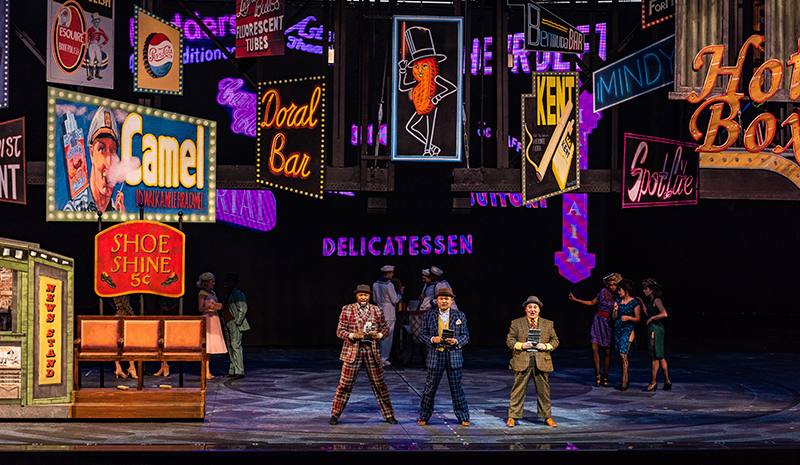
Digital Scenery
The video department at The Muny got some new tools to enhance productions as well as to help enhance the patron experience with LED screens and media servers to serve up the content. “We’ve had an LED screen up center stage and over the course of the past seven years it has grown and changed as we’ve gone on,” says Utzmyers. “We’ve had four different types of hardware with that wall. We started out at a 12mm resolution; then got higher resolution; then we got a properly outdoor-rated wall; now we have the F4IP, a 4mm IP65 outdoor-rated LED wall from Chauvet with NovaStar 4K processors. Now, the upstage LED wall is 23-feet high and 32-feet wide; then we have two LED walls, one on either side of stage mounted on the first torm; that are 23-feet tall and 10-feet wide. The side screens are used for scenery enhancement — to finish off the look. It just brings more depth to everything. Even when the boom is closed you can still see those screens, so we use them preshow for a bit of information — both scenery and digital signage. The video department uses disguise media servers to feed content to the LED screens. WorldStage helped us put this system together.”
The opening of the theater went well and Utzmyers and her technical teams worked with the new space and discovered what’s new. “We’re loving it, actually; it’s kind of been incredible,” she comments. “I certainly imagined, with all of the changes and brand-new equipment, that we would have a much rockier start than we’ve had. It was surprising and weird, but I’ll take it.” The Muny, at 101 years young, certainly gives new meaning to everything old is new again!
The Muny Renovation
Design Team:
- H3 – Architect
- Boyce Nemec Designs
- Code Consultants, Inc.
- David Mason + Associates
- Fisher Dachs Associates
- McClure Engineering
- SSE Inc.
- SWT Design
Construction Manager:
- Tarlton Corporation
Theatrical Suppliers:
- Bandit Lites
- Chauvet
- City Theatrical
- Color Kinetics
- disguise
- Elation Professional
- ETC
- Follow Me
- Masque Sound
- Tait
- TMB
- Tomcat
- WorldStage
- IATSE Local 6
